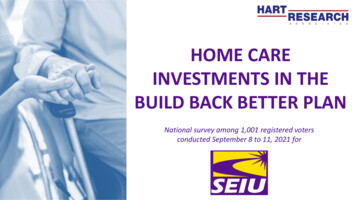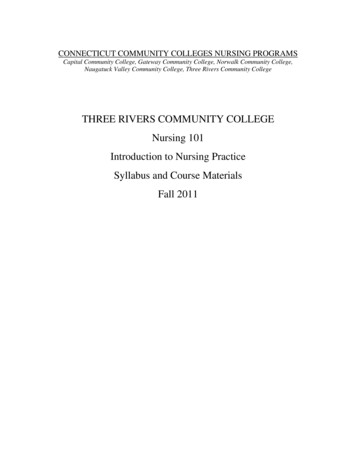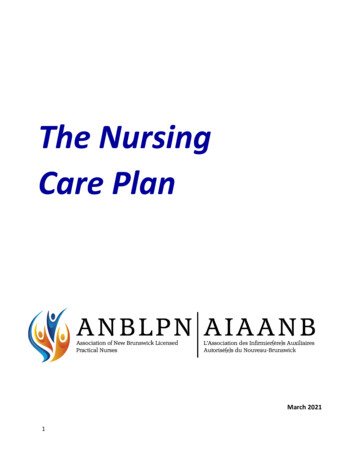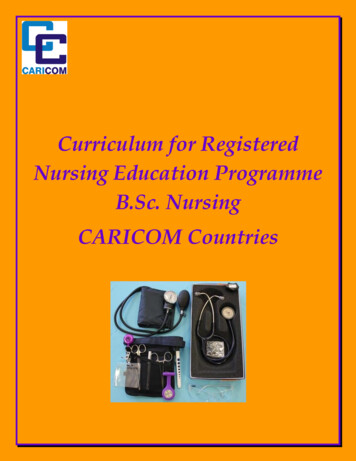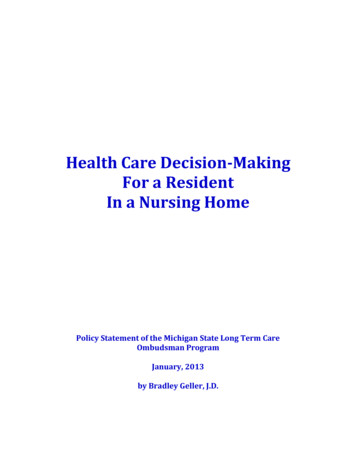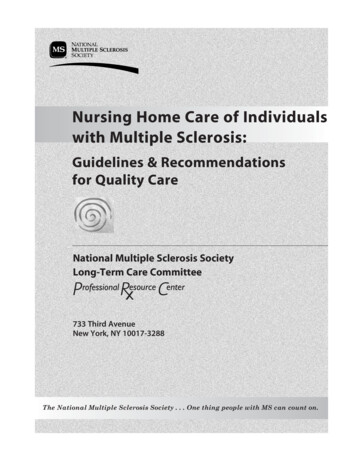
Transcription
Nursing Home Care of Individualswith Multiple Sclerosis:Guidelines & Recommendationsfor Quality CareNational Multiple Sclerosis SocietyLong-Term Care Committee733 Third AvenueNew York, NY 10017-3288The National Multiple Sclerosis Society . . . One thing people with MS can count on.
CONTENTSContributors/Reviewers . . . . . . . . . . . . . . . . . . . . . . . . . . . . . . . . . . . . . . . . . . . . . . . . . . . . . . . . . . . . . . .iiiPreface . . . . . . . . . . . . . . . . . . . . . . . . . . . . . . . . . . . . . . . . . . . . . . . . . . . . . . . . . . . . . . . . . . . . . . . . . . . . . . . . . .vResident Profile . . . . . . . . . . . . . . . . . . . . . . . . . . . . . . . . . . . . . . . . . . . . . . . . . . . . . . . . . . . . . . . . . . . . . . . . viiSection 1: Overview of Multiple Sclerosis . . . . . . . . . . . . . . . . . . . . . . . . . . . . . . . . . . . . . . . . . . . .1Section 2: Guidelines and Standards for Care . . . . . . . . . . . . . . . . . . . . . . . . . . . . . . . . . . . . . . .5Clinical and Nursing Issues . . . . . . . . . . . . . . . . . . . . . . . . . . . . . . . . . . . . . . . . . . . . . . . . . . . . . . . . . . . . .5MS Symptom Management . . . . . . . . . . . . . . . . . . . . . . . . . . . . . . . . . . . . . . . . . . . . . . . . . . . . . . . . . .5Complications of MS . . . . . . . . . . . . . . . . . . . . . . . . . . . . . . . . . . . . . . . . . . . . . . . . . . . . . . . . . . . . . . . . . 17Primary Health Care Needs . . . . . . . . . . . . . . . . . . . . . . . . . . . . . . . . . . . . . . . . . . . . . . . . . . . . . . . . . . . 20Psychosocial Issues . . . . . . . . . . . . . . . . . . . . . . . . . . . . . . . . . . . . . . . . . . . . . . . . . . . . . . . . . . . . . . . . . . . . . 25Daily Care Issues . . . . . . . . . . . . . . . . . . . . . . . . . . . . . . . . . . . . . . . . . . . . . . . . . . . . . . . . . . . . . . . . . . . . . . . 27Rehabilitation Issues . . . . . . . . . . . . . . . . . . . . . . . . . . . . . . . . . . . . . . . . . . . . . . . . . . . . . . . . . . . . . . . . . . . 30Availability of Rehabilitation Services . . . . . . . . . . . . . . . . . . . . . . . . . . . . . . . . . . . . . . . . . . . . . . . . . 30Wheelchairs, Equipment, Physical Environment, and Assistive Technology . . . . . . . . . . . . 31Neuropsychological Issues . . . . . . . . . . . . . . . . . . . . . . . . . . . . . . . . . . . . . . . . . . . . . . . . . . . . . . . . . . . . . . 34Section 3: The Nursing Home Admission Process . . . . . . . . . . . . . . . . . . . . . . . . . . . . . . . . . . . 37Section 4: Training Materials and Resources . . . . . . . . . . . . . . . . . . . . . . . . . . . . . . . . . . . . . . . . 39The National Multiple Sclerosis Society . . . . . . . . . . . . . . . . . . . . . . . . . . . . . . . . . . . . . . . . . . . . . . . . . 39Programs Offered by the NMSS . . . . . . . . . . . . . . . . . . . . . . . . . . . . . . . . . . . . . . . . . . . . . . . . . . . . . . 40Collaboration with Local NMSS Chapters . . . . . . . . . . . . . . . . . . . . . . . . . . . . . . . . . . . . . . . . . . . . . 41Professional Resource Center . . . . . . . . . . . . . . . . . . . . . . . . . . . . . . . . . . . . . . . . . . . . . . . . . . . . . . . . . 42Nursing Home Task Force . . . . . . . . . . . . . . . . . . . . . . . . . . . . . . . . . . . . . . . . . . . . . . . . . . . . . . . . . . . . 42i
Paralyzed Veterans of America (PVA) . . . . . . . . . . . . . . . . . . . . . . . . . . . . . . . . . . . . . . . . . . . . . . . . . . . . 42MS Clinical Practice Guidelines . . . . . . . . . . . . . . . . . . . . . . . . . . . . . . . . . . . . . . . . . . . . . . . . . . . . . . . 42MS Training Materials . . . . . . . . . . . . . . . . . . . . . . . . . . . . . . . . . . . . . . . . . . . . . . . . . . . . . . . . . . . . . . . . . . 43Models of Specialized Nursing Home Care . . . . . . . . . . . . . . . . . . . . . . . . . . . . . . . . . . . . . . . . . . . . . . 43Appendix A: Medications Commonly Used in MS . . . . . . . . . . . . . . . . . . . . . . . . . . . . . . . . . . . 45Appendix B: Recommended Resources . . . . . . . . . . . . . . . . . . . . . . . . . . . . . . . . . . . . . . . . . . . . . . 49General Readings . . . . . . . . . . . . . . . . . . . . . . . . . . . . . . . . . . . . . . . . . . . . . . . . . . . . . . . . . . . . . . . . . . . . . . 49Demos Medical Publishing . . . . . . . . . . . . . . . . . . . . . . . . . . . . . . . . . . . . . . . . . . . . . . . . . . . . . . . . . . . 49Additional Recommendations . . . . . . . . . . . . . . . . . . . . . . . . . . . . . . . . . . . . . . . . . . . . . . . . . . . . . . . . 50Information from the National Multiple Sclerosis Society . . . . . . . . . . . . . . . . . . . . . . . . . . . . . . . . 51Books for Healthcare Professionals . . . . . . . . . . . . . . . . . . . . . . . . . . . . . . . . . . . . . . . . . . . . . . . . . . . 51Booklets for Lay Audiences . . . . . . . . . . . . . . . . . . . . . . . . . . . . . . . . . . . . . . . . . . . . . . . . . . . . . . . . . . . 51Materials Available in Spanish . . . . . . . . . . . . . . . . . . . . . . . . . . . . . . . . . . . . . . . . . . . . . . . . . . . . . . . . 52Other MS Society Publications . . . . . . . . . . . . . . . . . . . . . . . . . . . . . . . . . . . . . . . . . . . . . . . . . . . . . . . . 52Web Sites . . . . . . . . . . . . . . . . . . . . . . . . . . . . . . . . . . . . . . . . . . . . . . . . . . . . . . . . . . . . . . . . . . . . . . . . . . . . . . 52Organizations . . . . . . . . . . . . . . . . . . . . . . . . . . . . . . . . . . . . . . . . . . . . . . . . . . . . . . . . . . . . . . . . . . . . . . . . . . 54Index . . . . . . . . . . . . . . . . . . . . . . . . . . . . . . . . . . . . . . . . . . . . . . . . . . . . . . . . . . . . . . . . . . . . . . . . . . . . . . . . . . . . 59ii
CONTRIBUTORS/REVIEWERSNational MS Society Long Term Care Committeeof the Medical Advisory BoardSusan WilkeyAndrew Goodman, MDDiane Afes, MAJim Ahearn, ACSWBarbara BernbaumDebra Frankel, MS, OTRJune GolinLinda JenckesJohn Lasfargues, MSLeon LeBuffe, PhDSarita Roy, MSW, CSWRandall Schapiro, MDMarva Serotkin, MPHAnne-Elizabeth Straub, MSW, CSWMary Long, RNNational MS Society Nursing Home Task ForceDiane Afes, MARobert Buchanan, PhDNancy Cassady, MHACarole Downing, MSW, LCSWDebra Frankel, MS, OTRLynda Hartman, RN, MSRuta Kadonoff, MHSSefi Knobel, MDCarolyn Konnert, LSWRobert Mendoza, PhDMaureen ReederMarva Serotkin, MPHElizabeth Shuster, MDSuzanne Smeltzer, EdD, RN, FAANAnne-Elizabeth Straub, CSW, CFTCindy Walsh, RN, BSN, A-CCCNational MS Society StaffNancy Holland, EdD, RN, MSCNNicholas LaRocca, PhDDorothy Northrop, MSW, ACSWNancy LawSusan Sanabria, MPAOther ReviewersAndrew Goodman, MDRandall Schapiro, MDKyle R. Nordine, BA, BSWMary Sturm Krueger, RN, BSN, CDONA, LNHANational Multiple Sclerosis Society 2003iii
DISCLAIMERThe content of this document is based on best practices andclinical experience of health care professionals specializing inthe care of people with multiple sclerosis. It is intended toprovide a guide for the care of people with MS in the nursinghome setting, but is not meant to substitute for, or to supersede, individualized physician treatment and advice.iv
PREFACEThis document was developed by the National Multiple Sclerosis Society (NMSS) toprovide guidance to clinicians and administrators of long term care facilities thatare seeking to develop more effective care plans to 1) manage the unique set of clinical conditions of their residents with MS, and 2) maximize the quality of life forthese residents.Multiple sclerosis is a complex, chronic disorder of the central nervous system thatoften generates needs for a range of long-term care services, including rehabilitation services, home care, adult day care, assisted living, and nursing home care.While only about 5–10% of the MS population require chronic nursing homecare, these individuals need targeted, specialized care that many nursing homesdo not have experience providing. When traditional geriatric care is not modifiedfor this population, the long-term care experience becomes more difficult thanit need be for both the staff and the residents. As compared to the frail elderlynursing home resident, residents with MS in nursing homes tend to: Be younger Be more mentally alert Be more physically dependent Present with more symptoms of depression and Have a longer length of stay1As a result, nursing home staff requires additional training and resources to best meetthe needs of this unique population.The NMSS is a leader in the initiation, support, and promotion of quality andage-appropriate care options for people with MS. Consistent with this responsibility,the Society brought together an expert panel of NMSS home office and chapterstaff, and MS specialists in the fields of mental health, social service, and longterm care, to identify the key components of a quality nursing home program forresidents with MS. This task force contributed their knowledge and clinicalexpertise to the preparation of this document through a series of meetings,research on best practices and preparation of several draft documents.1BuchananRJ, Wang SJ, Ju H. Analyses of the minimum data set: comparisons of nursing home residents with multiple sclerosis to other nursing home residents. Multiple Sclerosis (2002) 8: 512–522.v
This document is thus designed to be a practical resource for nursing staff, rehabilitationprofessionals, social workers, mental health professionals, and others involved in thedirect care of nursing home residents with MS. It is organized as follows:vi First, we provide some background on the disease itself, to provide the context forthe delivery of care. Next, we provide guidelines and standards of care in the areas of clinical/nursingissues, psychosocial functioning, daily care, rehabilitation, and neuropsychology. Third, we discuss some aspects of the nursing home placement and admissionprocess. Fourth, we offer resources and materials for additional information and training ofnursing home staff and other professionals involved in providing MS care. Finally, we offer two appendices: Medications Commonly Used in MS, andRecommended Resources.
RESIDENT PROFILEJulie is not a factual person, but a composite of several residents at a specialized longterm care facility for residents with MS.Julie is a 48 year old, single, white female who was admitted four years ago with adiagnosis of MS. She is a college graduate with an advanced degree in education andworked with learning disabled children prior to her admission. She had lived aloneand taught in a large school system. Her family consisted of her elderly parents, onesister and one brother who were both married with young children. Her brother livedout of state but her parents and sister lived nearby. Julie had always been veryindependent and took great satisfaction in being able to run her own life.In her mid-thirties, she had an episode of blurred and diminished vision and hadgone to her ophthalmologist to find out what was happening. He discovered opticneuritis and suggested she see a neurologist. She was subsequently diagnosed withMS. The diagnosis came as a shock, as she was quite healthy. She continued teaching but soon other symptoms appeared. She was embarrassed about her unsteadygait and worried that people might think she had been drinking. She began to havetrouble remembering appointments and processing information. Her reasoning andproblem solving were also diminished. Her disease progressed rapidly. She experienced trouble walking and progressed from using a cane to a wheelchair. Thesemobility issues and the cognitive decline ultimately caused her to resign her teaching position. She began receiving visiting nurse services (a home health aide) severaldays each week. By age 40, she was experiencing frequent falls at home, requiringher to call the fire department to assist her. She had trouble remembering to take hermedications and needed more and more help at home. Her parents were unable toprovide enough assistance, as they were elderly, with health problems of their own.She was admitted to the nursing home angry and frightened, when it seemed shecould no longer manage at home. The first several months were difficult as shetried to struggle with the loss of her independent life. She found that the constantcompany of others (including a roommate who played the TV too loud) and lack ofprivacy were difficult to adjust to. She resented having to share her aide with otherresidents and having to follow a schedule that was not always her choice. Shehated the Hoyer lift and all the other assaults to her independent spirit.After a year, Julie was unable to mobilize her own manual wheelchair. The facilityobtained a power chair for her and she loved the new freedom. She was able to govii
outdoors and find a private spot on her own and was able to explore the neighborhood,and visit the local library and shops with other residents.Julie’s vision became worse and her speech difficult to understand. She also had problemsoperating her power chair. The chair was modified with head controls, but she still haddifficulty controlling it, at one point running into another resident and a staff person(who needed to go to the emergency room for care). While everyone wanted Julie to beable to maintain her independence, they were also very concerned for her safety and thatof others in the facility.The next problem Julie encountered was difficulty feeding herself. She hated having to befed by an aide. She also had difficulty swallowing and began to choke on her food, butrefused a modified (pureed) diet. She felt this was as demeaning as eating baby food. Aspeech therapist evaluated her swallowing ability and recommended a feeding tube. Juliehad clearly specified her wishes against this in her Advanced Directive.***Julie’s story highlights the many challenges faced by the nursing home resident with MSas well as the staff who are trying to best meet her needs. She is a younger than expectednursing home resident who requires total care from nursing staff and at the same timedesires and insists on being independent and self-directed. These characteristics unite toplace challenging demands on the nursing home staff and on Julie to collaborativelydevelop a care plan that provides for her safety and health while promoting her independence.viii
SECTION1Overview of Multiple Sclerosis2Below is a general description of multiple sclerosis that accurately describes the overall MS population. Nursing home residents with MS on the whole, however, differ from most individualswith MS living in the community. Most nursing home residents have the most severe form of thedisease, and such symptoms as severe cognitive dysfunction and complete paralysis are muchmore prevalent in the nursing home population. Furthermore, the small percentage of peoplewith MS who may have a fatal course or significantly shortened life expectancy are concentrated in nursing home settings.Multiple sclerosis (MS) is a chronic, frequently progressive, neuroimmunologicdisease that attacks the myelin sheath surrounding the axons in the central nervoussystem (CNS—brain, spinal cord, and optic nerves). Demyelination occurs, oftenat multiple sites throughout the CNS. Irreversible damage to the axons themselvescan also occur, even in the earliest stages of the disease. It is hypothesized that anexternal “trigger” such as a virus or bacterium may precipitate an autoimmuneresponse in genetically susceptible individuals. The inflammatory, demyelinatingprocess can result in a wide variety of symptoms, including gait disturbances,sensory complaints (numbness, paresthesias, burning, feelings of constriction or pain),visual problems, fatigue, incoordination, bladder, bowel, and sexual dysfunction, andpartial or complete paralysis in severe cases. While cognitive impairment occurs inapproximately 50% of people with MS, only 10% experience serious intellectualdeterioration.The cause and cure of MS are unknown, although symptomatic management is possibleand certain immunoregulatory agents reduce the relapse rate and may also slowdisease progression.2Excerptedfrom Basic MS Facts by Nancy Holland, EdD, Clinical Bulletin, Professional ResourceCenter, NMSS, revised 2002.
It is important to note that MS is not contagious, is not usually fatal, or hereditary,although a genetic predisposition is probable and being studied. Onset of symptoms forthe majority of people with MS occurs between the ages of 20 and 50. The compositepicture of a person with MS is: Caucasian (whites are diagnosed more often than otherracial groups), 30 years of age, female (females are affected more than twice as often asmales) and living in one of the temperate areas of the world.In general, the nearer to the equator a person lives, the less risk he/she has of acquiringMS. In the U.S., the estimated prevalence rate is 100–150/100,000, above the 37th parallel.Below the 37th parallel the rate is 57–78/100,000. Overall, perhaps 400,000 people in theU.S. have MS.There is no single definitive diagnostic test for MS, although certain laboratory tests arecommonly used to support neurologic findings that suggest MS. Diagnosis is primarilyestablished by patient history and neurologic examination. Magnetic resonance imaging(MRI) and electrodiagnostic procedures such as evoked potential measurement are oftenhelpful to confirm a suspected MS diagnosis. Lumbar puncture, often needed to firmlyestablish the diagnosis of MS, is positive when oligoclonal bands or other evidence ofimmunoglobulin synthesis are present in the cerebrospinal fluid (CSF).The clinical course of MS usually falls within one of the following categories, with thepotential for progression from one pattern to a more serious one:2 Relapsing-Remitting MS: Persons classified as having relapsing-remitting MS experience clearly defined relapses—episodes of acute worsening of neurologic function—followed by periods of remission without disease progression. In some cases, peopleexperience a residual deficit. Secondary Progressive MS: People with secondary progressive MS experience arelapsing-remitting disease course at onset, followed by progression with or withoutoccasional relapses, minor remissions, and plateaus. Although the disease usuallybegins in the relapsing-remitting category, most individuals eventually convert tothe progressive category. Progressive-Relapsing MS: Persons with progressive-relapsing MS experience progressivedisease from onset, with clear, acute relapses that may or may not resolve with fullrecovery. Unlike relapsing-remitting MS, the periods between relapses are characterizedby continuing disease progression. Primary Progressive MS: People with primary progressive MS experience a nearlycontinuous worsening of disease that, by definition, is not interrupted by distinctrelapses. Some of these individuals do have occasional plateaus and temporary minorimprovements. Health professionals tend to have greater exposure to individualswith the more serious forms of the disease. Therefore, it is important to note that themajority of individuals with MS do not become severely disabled.
Management of MS involves the following: Symptomatic Management: Improve function, relieve discomfort, and preventcomplications and secondary disability through medical and rehabilitation therapies. Quality of Life Interventions: Address psychosocial and other issues regarding copingand adaptation. Relapse Management: Treat acute relapses (flare-ups, attacks, exacerbations) in orderto shorten the duration and reduce the severity. Most physicians prescribe IV steroidsto treat those relapses that are severe. Disease Modification: Reduce number of relapses, rate of progression and developmentof new lesions; currently approved are Betaseron , Avonex , Copaxone , Rebif , andNovantrone .3
SECTION2Guidelines and Standards for CareThese guidelines, while specific to multiple sclerosis for our purpose here, may well apply toother nursing home residents. Many of the recommendations regarding psychosocial issuesand quality of life are relevant to all adults. Few studies at this time are specific to the longterm care of individuals with advanced stages of MS. The following guidelines and standardsare based upon scientific and clinical information currently available and the practical experience of the long-term care facilities’ staff that specialize in this type of care.CLINICAL AND NURSING ISSUES3While some of the symptoms of MS are seen in other disorders and may be familiarto nursing home staff, the severity, clustering, and nature of these symptoms presenta unique challenge to nursing and rehabilitation management. It is crucial thatnursing home staff be aware of the unique ways these symptoms present in personswith MS, the impact on their day-to-day lives, and potential treatments and strategies for management of care.MS Symptom ManagementClinicians should be aware of the following symptoms as they develop a daily care plan forresidents with MS:3Somematerial above adapted from Halper J, Murray JT: Primary care needs of MS patients. In van denNoort S, Holland N (eds.): Multiple Sclerosis in Clinical Practice. New York: Demos Medical Publishing,1999; and from Halper J, Holland N: Comprehensive Nursing Care in Multiple Sclerosis (2nd ed.). NewYork: with permission of Demos Medical Publishing, 2002.
SpasticityManagement ofspasticity or musclehypertonia is achallenge because ofconcurrent symptomssuch as weaknessand fatigue.Management consists of stretching programs and pharmacologic agents such as baclofen, diazepam, dantrolene sodium,and tizanidine. Some patients with severe spasticity havebenefited from intrathecal baclofen delivered by animplantable pump. Botulinum toxin injected directly intothe muscle has also been beneficial to some patients. The useof phenol blocks and surgical techniques, while beneficial tosome, are used less frequently since the advent of the baclofenpump. If spasticity is not managed, complications such asskin breakdown, contractures, and pain can occur.TIPS: Spasticity1. Health care workers need to be reminded that muscle spasms are involuntary.Telling the resident to “relax” will likely make things worse. It is best to stopwhatever you are doing with the resident, if possible, and wait until the spasmpasses before proceeding.2. Avoid quick, sudden movement of the resident’s limbs that can set off spasms.Instead, tell the resident what you plan to do and rest your hands firmly on thelimb before moving it. Move slowly and smoothly.3. Stretching is different from the passive range of motion that is taught to nursingassistants in their basic training. It is slower and positions are held longer. It isadvisable to train a few “restorative aides” to provide these stretching exercisesto residents. A typical maintenance schedule is 20 minutes 3 times a week. Whilethese exercises can be done in bed, it is preferable to perform stretching on aphysical therapy mat for maximum stretch and for minimal risk of muscle strainto the aides.4. Spasticity increases the risk of injury to the nursing assistants during pivottransfers. These residents should always be transferred by an electric lift with2 persons in attendance. Electric lifts are preferable to mechanical lifts becausethe lifting motion is smoother and less likely to stimulate a spasm.5. Residents with spasticity should be encouraged to always wear seat belts when outof bed in a shower chair, wheelchair, or recliner. A sudden spasm can cause themto slide out of the chair or even topple a commode chair. The seatbelt serves as apositioning device to stabilize their trunk during spasms—not as a restraint.6
TremorThe most commontremor in MS is aslow gross intentiontremor that occurswith purposefulmovement of the armor leg. This type oftremor is often exaggerated with stress.Some drugs, including hydroxyzine, clonazepam, propranolol, primidone, and isoniazide may help in addition tophysical techniques, e.g., weighting, immobilization, andpatterning. Tremors are very challenging to control. Speechtherapy may help control tremors of the lips, tongue, andjaw.TIP: Tremor1. Tremor and spasticity can significantly impair a resident’s ability to drive theirpower wheelchairs. Providing good arm support so that the resident’s arm is atrest while driving, and joystick controls that require only a “light touch” mayimprove their driving ability. Seek out wheelchair seating specialists at rehabilitationcenters and/or wheelchair companies for consultation.BalanceBalance problemsoften result in anunsteady gait ortrunk instability.Therapeutic exercises with a Swiss Ball and other techniquesthat challenge the patient’s balance may be helpful in stimulating balance centers and improving balance but occupationand physical therapy measures for appropriate support whilesitting may be necessary. Attention to sitting balance is animportant safety concern.TIPS: Balance1. A chair alarm that is clipped to the resident’s clothing can be helpful as a reminderto residents with poor balance to “sit back.” The alarm goes off when they areleaning too far forward and can call staff if the resident has lost their balance andis slumped over the side of the chair.2. Side trunk supports and seat belts (as positioning devices, not as restraints) are thebest options for seating balance, as are wheelchairs with a “tilt” feature.3. Use lift slings made of mesh and without bulky seams and leave them under theresident when they are sitting in the wheelchair. This will allow the nursingassistants to easily re-attach the lift and reposition residents who have slumpedover in their chairs.7
WeaknessWeakness may resultfrom both disuse andfrom interruptedneurotransmission.Strengthening exercises may improve strength of musclesweak from disuse but will not improve muscle weaknesssecondary to poor transmission. Managing weakness mustbe done in conjunction with management of spasticity andfatigue to be effective.FatiguePeople with MS mayexperience normalfatigue, fatigue ofdepression, the fatigueof disease, and thefatigue of neuromuscular overuse.MS fatigue, an overwhelming lassitude, may be treated withamantadine, fluoxetine, or methylphenidate. A newerapproach includes use of modafinil, a drug approved for thetreatment of narcolepsy. Occupational therapists can adviseon energy saving techniques. Overheating should beavoided.TIPS: Fatigue1. A sudden increase in fatigue level is often the first sign of infection in residentswith MS. Always monitor the resident’s temperature when there is a sudden onsetof fatigue. If the resident has a history of urinary tract infections, it is advisable toobtain a urinalysis as soon as possible.2. Nursing home routines often trigger fatigue in MS residents. Try to scheduletherapy and activities and meals with rest periods in between. It may notrequire that the resident go back to bed but simply have some “quiet” timewith their wheelchair in tilt position to conserve energy.3. Guided meditation is a useful activity to manage fatigue.4. Provide most nutrition through the morning and noontime meals. Most residentswith MS are too tired in the evening to eat hearty meals.5. Always consider poor hydration as one cause of fatigue particularly in residentswith difficulty swallowing liquids.8
VisionOptic neuritis, causing pain and acutevision loss is common in MS as isdouble vision andnystagmus. Cataractsmay develop at ayounger age in persons with MS becausecorticosteroids maypromote their development.As with other MS symptoms, visual disturbances mayincrease with fatigue, stress, and high temperatures.Some residents may benefit from a consultation with aneuroophthalmologist or low vision center.TIPS: Vision1. Most residents with MS require large screen TVs set on tables that can be wheeledclose to their bedside.2. Many MS residents qualify for services for the legally blind such as large printbooks, talking book players, and free rental of talking books that are maileddirectly to the nursing home.3. The easiest written material for residents with MS to read is plain black letteringon white paper in at least a size 14 font.4. Contrasting colors on doorframes will assist residents with MS to enter and exitrooms in their power wheelchairs with fewer collisions.9
ParesthesiaNumbness and tingling are common inMS. Some residentswith MS may experience sensitivity totouch or experienceabnormal sensationsin response to touch.Many residents withMS experience anelectric shock sensation upon neckflexion calledL’Hermitte’s sign.Sensory disturbances may present a safety concern inbathing and feeding (exposure to hot water, beverages, andfood), smoking and wheelchair driving. Also, numbness maydelay or prevent an individual from reporting that they havebeen incontinent.TIPS: Paresthesia1. Some residents with MS may experience a burning or stinging sensation on thesoles of their feet that may last days to weeks before spontaneously ceasing.Gabapentin (Neurontin) may help but generally, comfort measures work best.The resident may prefer to not wear shoes or socks and to use a foot cradle whilein bed. Light foot massage with topical anesthetics may provide temporary relief,as do ice packs at times. Reassure the resident that it will pass and try to distractthem with socialization rather than allowing them to stay in bed.2. Frequent skin checks during AM and PM care is essential since these residentsseldom report collisions, scrapes and cuts because they either did not feel it,could not see it or forgot.10
Bowel DysfunctionPeople with MS mayexperience constipation as a result ofinadequate fluid orbulk in the diet,decreased physicalactivity, medications,and from MS involvement that may slowthe bowel or weakenabdomi
ulation. Nursing home residents with MS on the whole, however, differ from most individuals with MS living in the community. Most nursing home residents have the most severe form of the disease, and such symptoms as severe cognitive dysfunction and complete paralysis are much more prevalent in the nursing home population.



